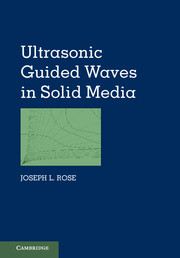Book contents
- Frontmatter
- Contents
- Nomenclature
- Preface
- Acknowledgments
- 1 Introduction
- 2 Dispersion Principles
- 3 Unbounded Isotropic and Anisotropic Media
- 4 Reflection and Refraction
- 5 Oblique Incidence
- 6 Waves in Plates
- 7 Surface and Subsurface Waves
- 8 Finite Element Method for Guided Wave Mechanics
- 9 The Semi-Analytical Finite Element Method
- 10 Guided Waves in Hollow Cylinders
- 11 Circumferential Guided Waves
- 12 Guided Waves in Layered Structures
- 13 Source Influence on Guided Wave Excitation
- 14 Horizontal Shear
- 15 Guided Waves in Anisotropic Media
- 16 Guided Wave Phased Arrays in Piping
- 17 Guided Waves in Viscoelastic Media
- 18 Ultrasonic Vibrations
- 19 Guided Wave Array Transducers
- 20 Introduction to Guided Wave Nonlinear Methods
- 21 Guided Wave Imaging Methods
- Appendix A Ultrasonic Nondestructive Testing Principles, Analysis, and Display Technology
- Appendix B Basic Formulas and Concepts in the Theory of Elasticity
- Appendix C Physically Based Signal Processing Concepts for Guided Waves
- Appendix D Guided Wave Mode and Frequency Selection Tips
- Index
- Plates
- References
21 - Guided Wave Imaging Methods
Published online by Cambridge University Press: 05 July 2014
- Frontmatter
- Contents
- Nomenclature
- Preface
- Acknowledgments
- 1 Introduction
- 2 Dispersion Principles
- 3 Unbounded Isotropic and Anisotropic Media
- 4 Reflection and Refraction
- 5 Oblique Incidence
- 6 Waves in Plates
- 7 Surface and Subsurface Waves
- 8 Finite Element Method for Guided Wave Mechanics
- 9 The Semi-Analytical Finite Element Method
- 10 Guided Waves in Hollow Cylinders
- 11 Circumferential Guided Waves
- 12 Guided Waves in Layered Structures
- 13 Source Influence on Guided Wave Excitation
- 14 Horizontal Shear
- 15 Guided Waves in Anisotropic Media
- 16 Guided Wave Phased Arrays in Piping
- 17 Guided Waves in Viscoelastic Media
- 18 Ultrasonic Vibrations
- 19 Guided Wave Array Transducers
- 20 Introduction to Guided Wave Nonlinear Methods
- 21 Guided Wave Imaging Methods
- Appendix A Ultrasonic Nondestructive Testing Principles, Analysis, and Display Technology
- Appendix B Basic Formulas and Concepts in the Theory of Elasticity
- Appendix C Physically Based Signal Processing Concepts for Guided Waves
- Appendix D Guided Wave Mode and Frequency Selection Tips
- Index
- Plates
- References
Summary
Guided wave imaging methods are extremely popular and useful for evaluating defect locations and sizes in guided wave inspection. Interpretation is easier and preferred when compared to studying complex RF waveforms. Images are generally reconstructed from the RF waveforms in a variety of ways. A few imaging methods are discussed here, including the following:
Guided Wave through Transmission Dual Probe Imaging
Defect Locus Map
Guided Wave Tomographic Imaging
Guided Wave Phased Array in Plates
Long-Range Ultrasonic Guided Wave Pipe Inspection Images
Introduction
Imaging methods in nondestructive evaluation (NHM) are preferred whenever possible, compared to results presented in RF waveform format. Imaging results are easier to read, to interpret, and to convince others of a result. RF waveforms can be complex and difficult to analyze, often calling for sophisticated signal processing and pattern recognition analysis. As a result, a discussion of several guided wave imaging methods are presented in this chapter.
Guided Wave through Transmission Dual Probe Imaging
A number of guided wave through transmission dual probe configurations have been used for defect imaging purposes. The two probes are fairly close together and scan from one to eight inches apart. The idea stems from an acousto-ultrasonic approach by Vary (1987). At that time, two normal beam probes were placed close to each other and an ultrasonic signature of the test piece was taken that often depicted a good or bad character of the component being tested. The method was also developed to assist in acoustic emission development programs where a sending transducer was used to imitate an acousto emission signal for subsequent capture and analysis by an acoustic emission sensor and analysis system.
Information
- Type
- Chapter
- Information
- Ultrasonic Guided Waves in Solid Media , pp. 402 - 420Publisher: Cambridge University PressPrint publication year: 2014
References
Accessibility standard: Unknown
Why this information is here
This section outlines the accessibility features of this content - including support for screen readers, full keyboard navigation and high-contrast display options. This may not be relevant for you.Accessibility Information
- 1
- Cited by
